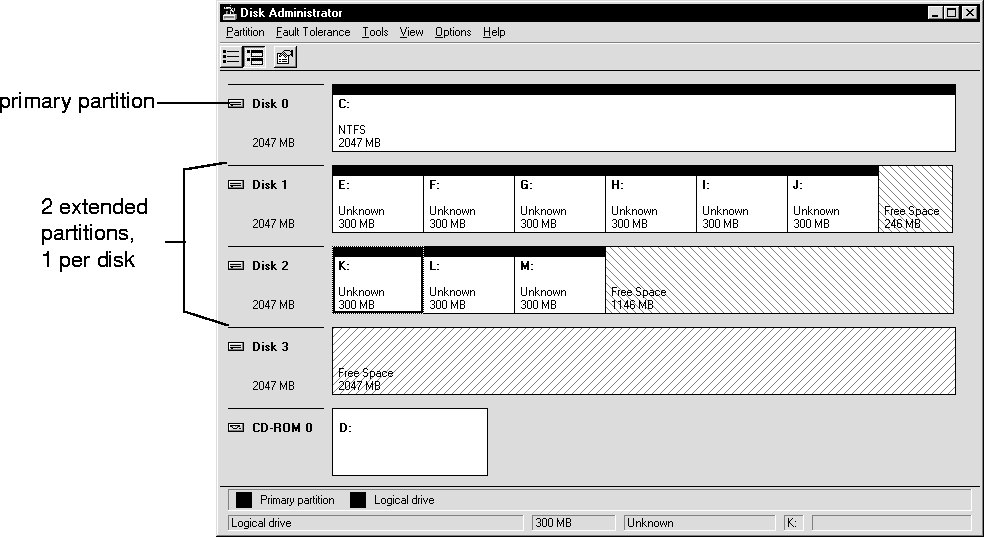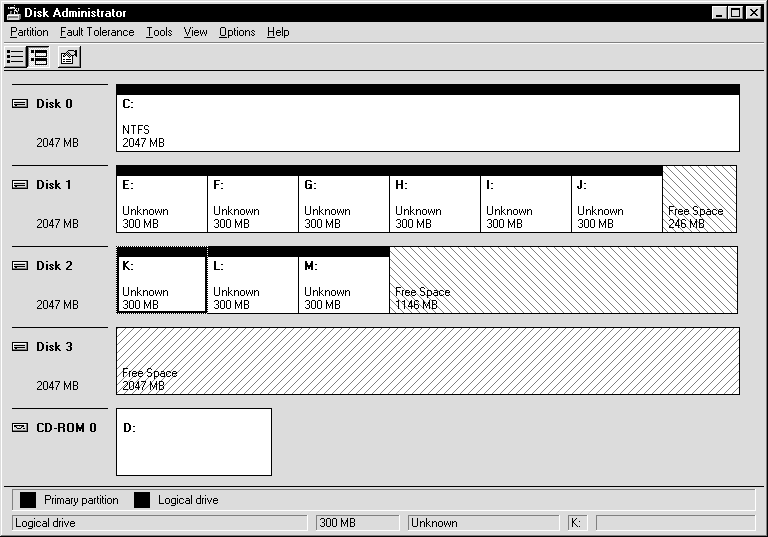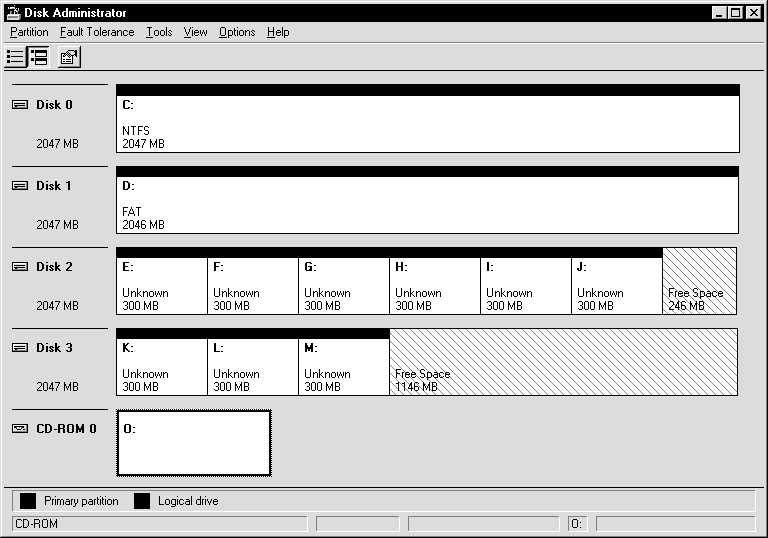Release 8.0.5 for Windows NT
A64425-01
Library |
Product |
Contents |
Index |
| Oracle
Parallel Server Getting Started
Release 8.0.5 for Windows NT A64425-01 |
|
This chapter describes required pre-installation tasks.
Specific topics discussed are:
Because no true distributed file system support exists on
Windows NT, the mechanism Oracle uses to allow nodes running different
instances to access shared disks is to bypass the NT file system by using
raw partitions. The shared disks are then a collection of unformatted raw
devices.
A raw partition is a portion of a physical disk that is accessed
at the lowest possible level. I/O to a raw partition offers approximately
a 5% to 10% performance improvement over I/O to a partition with a file
system on it.
A raw partition is created when an extended partition is
created and logical partitions are assigned to it without applying any
formatting. The Windows NT Disk Administrator application allows you to
create an extended partition on a physical drive.
An extended partition points to raw space on the disk that
can be assigned multiple logical partitions for the database files. An
extended partition avoids the four-partition limit by allowing you to define
large numbers of logical partitions to accommodate applications using Oracle8
Enterprise Edition. Logical partitions can then be given symbolic link
names to free up drive letters. We create an extended partition in this
chapter and link the drive letters to symbolic link names in Chapter
5, "Configuring Oracle Parallel Server".
The Disk Administrator window shown below shows four
disks, two of the disks having an extended partition:

Windows NT defines each disk drive found at startup with the following naming convention:
where Harddiskm is the number of the physical drive, and Partitionn is a logical partition number, as shown in the Disk Administrator window (in Figure 3-1). Harddiskm starts at 0, and Partitionn starts at 1. Partition0 has a special meaning in that it has access to the whole disk. For example, the first logical partition (E:) on the second physical drive in Figure 3-1has the following entry:
The first logical partition on a system (normally the C drive) has the following entry:
Raw partitions are of two types:
|
Note: Although you can use physical disks, Oracle Corporation recommends using logical partitions and creating symbolic links (as described in section "Step 2: Assign Symbolic Links to Each Logical Partition" in Chapter 5, "Configuring Oracle Parallel Server"). |
A physical disk represents the entire disk. It points to
\Device\Harddiskx\Partition0. Windows NT automatically creates a
symbolic link name of \\.\PhysicalDrivex, where x is the
number corresponding to your hard disk drive number in the Disk Administrator.
The x matches the x in \Device\Harddiskx\Partition0.
\\.\PhysicalDrivex is automatically defined by Windows NT for every hard disk in the machine. For example, a machine with three hard disks will have the following names defined by Windows NT:
Internally, these names expand to:
\\.\PhysicalDrive0 = \Device\Harddisk0\Partition0
\\.\PhysicalDrive1 =\Device\Harddisk1\Partition0
\\.\PhysicalDrive2 =\Device\Harddisk2\Partition0
Partition0 is special in that it represents the entire physical
disk regardless of any partitioning scheme on that disk. On all disks recognized
by Windows NT, the Disk Administrator writes a signature on the first block
of all disks. To avoid overwriting that block, Oracle skips the first block
of a physical raw partition which is used for an Oracle data file.
A logical partition is a partition created by the Disk
Administrator that points to a drive other than \Device\Harddiskx\Partition0.
Logical partitions are initially assigned names with drive letters (\\.\drive_letter:)
and typically re-assigned symbolic link names (\\.\symbolic link name).
For example, \\.\D: may be assigned a symbolic link name of \\.\OPS_SYS01.
Regardless of whether a drive letter or symbolic link name is used, logical
partitions are defined to represent a specific partition in a disk rather
than the entire disk. Internally, these names may expand to:
\\.\D:= \Device\Harddisk2\Partition1
\\.\OPS_SYS01= \Device\Harddisk3\Partition2
Drive letters can be assigned to specific partitions using
the Disk Administrator, while symbolic link names can be assigned
using a utility such as DOSDEV.EXE, which is available with the Windows
NT Resource Kit, or the SETLINKS utility (shipped with the Parallel Server
Option).
|
Note: Oracle does not skip the first block of a logical raw partition used for an Oracle data file. |
Please consider the following when deciding which raw partition to use:
Question: What is the impact if I have created logical partitions, but defined physical disk convention names for them. For example:
\\.\PhysicalDriveSYS01 = \Device\Harddisk2\Partition1
\\.\PhysicalDriveUSR01 =\Device\Harddisk3\Partition1
Answer: Oracle database will handle the data file
using the physical disk convention, even though it really is a logical
partition. This will not cause any data corruption or loss, as long as
you continue using the physical disk naming conventions. Oracle Corporation
recommend that you convert to the logical partition at your earliest convenience.
See "Compatibility Issues" in this chapter.
Question: What is the impact if I have created logical names representing Partition0. For example:
Answer: This will pose severe problems, as the Disk
Administrator typically writes a signature into the first block of every
disk, and consequently may overwrite a portion of the data file header.
This may also cause data loss. Never use Partition0 with
the logical partition convention. See "Compatibility
Issues" below for information on rebuilding your Oracle database with
the proper conventions.
Question: How do I transfer the contents of any raw
partition to a standard file system for backup purposes?
Answer: Use the Oracle provided OCOPY to copy data to/from a raw partition for both physical and logical raw conventions. See "Compatibility Issues" below for further information.
The physical and logical partition conventions are not compatible
with one another due to the extra block that is skipped for physical raw
conventions. This also means you cannot simply do an OCOPY from a physical
disk to a logical partition, as the contents of these partitions are incompatible.
To convert from a physical convention to a logical convention, you must:
If your database installation uses physical disk conventions
with logical partitions, Oracle Corporation recommends converting to the
logical partition conventions at your earliest convenience using the steps
above.
Only one extended partition can be created per disk. You
can use the free space in the extended partition to create multiple logical
partitions or use all or part of it when creating volume sets or other
kinds of volumes for fault-tolerance purposes.
To create an extended partition:
The Disk Administrator window appears:
Note the lines display diagonally from top right to the bottom left, indicating unpartitioned devices.
Oracle recommends you use the entire disk.
The Disk Administrator displays the minimum and maximum sizes for the extended partition:
|
Note: Changes you have made are not saved until you choose Commit Changes Now Commit Changes Now from the Partition menu or quit the Disk Administrator. |
The extended partition is created.
Note the lines now display diagonally from top left to bottom right, indicating the partition is an extended partition.
After an extended drive is created, you must assign logical
partitions to it. Logical partitions are assigned letters of the alphabet.
To create logical partitions in an extended partition:
The Disk Administrator window displays the minimum and maximum sizes for the logical partition:
The size is dependent on how large you want your log files
and data files to be. Add 2MB to this size for overhead. If you plan on
using the default database OPS.SQL creation script (to be used later) located
in ORACLE_HOME\OPS to create your database later, 300 MB is more
than enough.
| Additional
Information:
See "Step 7: Create an Oracle Parallel Server Database" in Chapter 5, "Configuring Oracle Parallel Server", for more information about OPS.SQL. |
|
Attention: A two-node cluster requires 9 drives, and each additional node requires 2 additional drives to accommodate log files. |
A confirmation dialog appears, informing you changes have been made to the disk.
A dialog box appears, informing you the disks have been updated successfully.
On all nodes except the primary node, a dialog box appears, informing you the disk configuration has been detected. If you do not see this dialog box, it does not mean the disk configuration has not changed.
The extended partition and the logical partitions are now
seen by all of the nodes.
|
Note: The hard disks that access the shared area may be different from node to node. The logical partitions, however, that reside on the hard disks must be identical on all nodes. |
For example, Node 1 may look like:


On Node 1, the logical partition E is defined as \Device\Harddisk1\Partition1.
On Node 2, it is defined as \Device\Harddisk2\Partition1. Even though these
map to different disks, they map to the same space on the shared disk.
To free up other drive letters for other purposes, such as
mapping network drives, it is important to also unassign the drive letters
from the logical partitions on each partition. Oracle Parallel Server does
not need to access a partition through a drive letter.
|
Note: A two-node cluster requires 9 logical partitions, for example, with drive letters E through M. Each additional node requires two additional drives to accommodate the log files. |
|
Note: If your disks have been previously configured, the logical partitions may already be unassigned. If this the case, you can skip to Step 6 of this procedure. |
To unassign drive letters:
The Assign Drive Letter dialog box appears:
A confirmation dialog box appears.
|
Note: The hard disks that access the shared area may be different from node to node. The logical partitions, however, that reside on the hard disks must be identical from node to node. |
Oracle Corporation recommends using a worksheet similar
to the one below.
| Node 1 | Node 2 | Node 3 | Node 4 | |
|---|---|---|---|---|
|
Hard Diskx |
Partitions x-x |
Partitions x-x |
Partitions x-x |
Partitions x-x |
|
Hard Diskx |
Partitions x-x |
Partitions x-x |
Partitions x-x |
Partitions x-x |
For example, the worksheet for the Disk Administrator
windows shown in Figure 3-2 and Figure
3-3 of this chapter would look like:
| Node 1 | Node 2 | |
|---|---|---|
|
Hard Disk1 |
Partitions 1-6 |
n/a |
|
Hard Disk2 |
Partitions 1-3 |
Partitions 1-6 |
|
Hard Disk3 |
n/a |
Partitions 1-3 |
The Disk Administrator application exits.